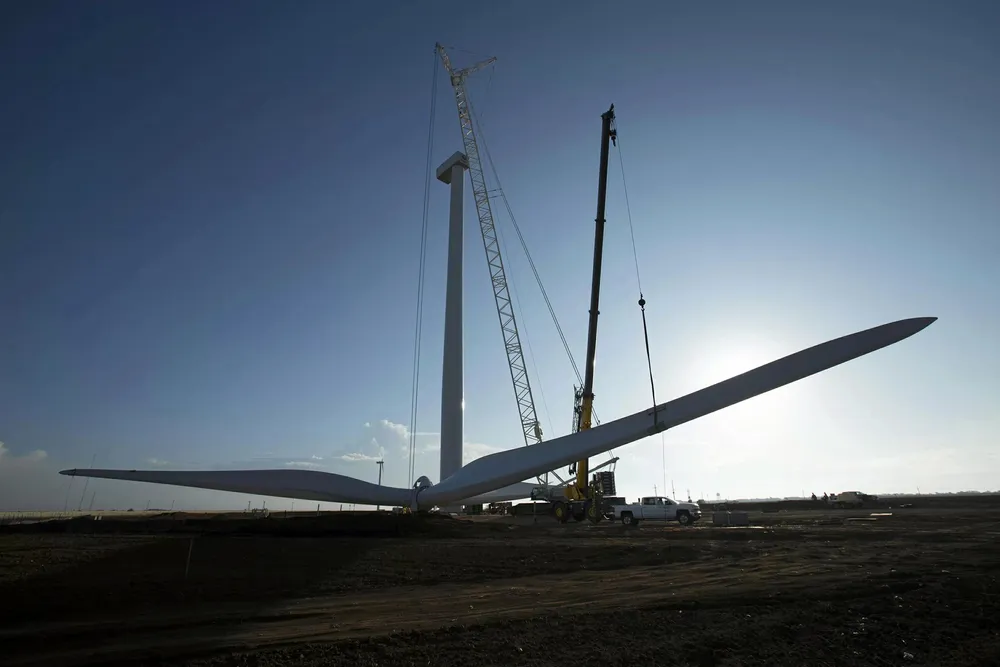Wind blade maker eyes US restart to serve GE Vernova turbines
Boost for sector under pressure from Donald Trump as TPI Composites looks to take Iowa plant out of mothballs

TPI Composites aims to restart onshore wind turbine blade production in the US under contract to GE Vernova “towards the tail end of the second quarter,” according to CEO Bill Siwek.
It’s rare positive news for a sector that has been on the defensive since President Donald Trump took office last month vowing to halt development offshore, while refusing to give onshore wind a place at his administration’s table as it formulates national energy policies.
TPI mothballed the Newton, Iowa, plant in 2021, shifting production across the border to Juarez, Mexico. It also served the US market from a factory in India.
Local media reported TPI will invest about $3.2m to renovate the facility and update equipment and technology. Iowa is providing a $500,000 forgivable loan to support the project.
Siwak on a recent earnings call said the Iowa facility will initially dedicate two production lines to support the OEM’s 2MW platform, which has proven to be a popular option for repowering thousands of older GE Vernova turbines.
A partial repower usually includes major retrofits, defined as complete replacement of the turbine’s rotor and blades, along with swap out of at least one major component within the nacelle. The foundation and tower are retained.
The Investment of 50% to 80% of the cost of a new build turbine, depending on scope of work, to refresh and enhance performance allows it to be eligible for another decade of federal production tax credits.
The plant expects to create more than 400 jobs with further hirings likely should the two companies expand their collaboration there, which is under discussion.
“Our customer will wait until there’s a little bit more certainty with respect to policy and demand before we make a decision to expand beyond the two lines,” said Siwek.
Blades and hubs account for about 60% of onshore wind turbine-related imports by dollar volume, according to the US International Trade Commission, a federal agency. Mexico and India are by far the biggest suppliers, reflecting TPI’s role.
When TPI’s Iowa blade facility comes online, it will be the only one in the US not owned by GE Vernova, Siemens Gamesa, or Vestas.
While Trump is hostile toward wind energy, it is unclear to what extent, if at all, his administration would try and thwart development onshore where about 95% occurs on private property.
In a minority of cases, federal permits may be required if access roads and transmission lines cross US lands, or if projects affect sensitive US wetlands, or may endanger federally protected species.
Projects also need to obtain a determination of no hazard by the Federal Aviation Administration, although it is unclear whether this constitutes an approval or permit, according to Norton Rose Fulbright law firm.
Trump directed executive branch agencies not to issue new or renewed approvals, rights of way, permits, or leases for onshore wind projects pending completion of a full assessment and review of federal wind leasing and permitting practices.
What effect, if any, his order could have on turbine repowering is uncertain. Some asset owners believe this does not require new federal approvals and permits, only those at the state level.
Siwek said TPI has not felt any direct impacts from Trump’s executive orders affecting wind energy. Its order book for the US market is solid for 2025 as developers rushed to qualify projects for lucrative federal tax credits throughout last year.
Trump, ironically, has given priority to resolving grid congestion and sluggish permitting processes, the two biggest challenges facing all energy projects regardless of technology.
Despite the immediate market challenges and uncertainty including Trump tariff threats, Siwek revealed that TPI has been in supply discussions with OEMs other than GE Vernova for later this decade for US-sourced blades.
Last year, TPI secured further US capacity. He described the site as a former blade facility, saying it is a very good geographic location to serve “pretty important and large wind projects.” It could accommodate four production lines depending on blade size, according to Siwek.
He said timing "will depend on ultimate certainty with policy," noting this facility "was really never meant for 2025 volume."
(Copyright)